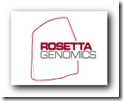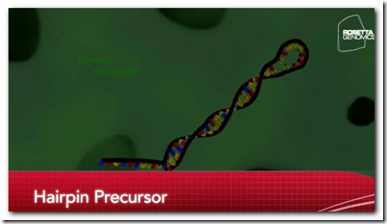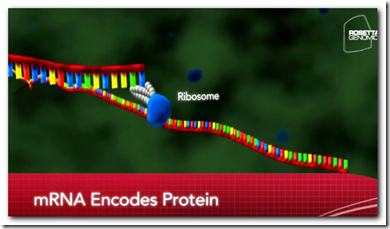Tests to detect cancer of the unknown primary
Rosetta Genomics – Today I had the opportunity to speak with and interview Ronen Tamir, Chief Commercialization Officer, at Rosetta to find out how  microRNA is helping diagnose and treat cancer.
microRNA is helping diagnose and treat cancer.
If you have been keeping up with the news of late, Rosetta in the last couple of weeks has had 3 press releases announcing their new microRNA tests which they will begin offering to help doctors analyze and determine diagnosis of certain types of lung cancer and where cancer has it’s origins. This is expected to help doctors decide what type of cancer is to be treated. The use of microRNAs will give accurate information about the cancer they are dealing with and aid doctors in guiding personalized treatment plans, specific to the type of cancer that is detected.
In other words, a tumor from the lung might not actually be lung cancer, but rather a cancer that has originated in another organ that has traveled through the body and has formed a metastasis in the lung area. Today, cancer treatment plans are varied and with genomic research, we now are beginning to have the ability to treat each cancer specifically. Certain types of therapy that might work well for some types of cancer, may not work as well or at all for other types of cancer found in the body.
With the acquisition of Parkway Clinical Labs, Rosetta has positioned itself with a location in Philadelphia that will be geographically friendly to many hospitals and universities on the east coast and will serve the entire nation and the rest of the world. Lab results can be returned in 10 days or so. Rosetta Genomics has it’s roots in Israel and has been working with oncology research since the year 2000.
MicroRNAs are now being considered “The Master Switch of the Body”, Mr. Tamir stated, and by determining the level of expression of specific MicroRNAs, we can make diagnostic decisions. The use of microRNAs are able to report a very high rate of accuracy as well, not seen with other tests used. Also, what is also unique is the fact that Rosetta’s tests use Formalin Fixed Paraffin Embedded (FFPE) tissue samples, whereby the tissue is saved in a container that does not require any type of special care other than room temperature and the lab can use the 3-10 slices to extract the microRNA without any additional issues for a physician to deal with such as having to use dry ice, etc.
Rosetta has also been working with institutions such as the M.D. Anderson Cancer Center and Johns Hopkins and has a couple partnerships with pharmaceutical companies in the area of developing cancer therapies.
Isis Pharmaceuticals Regulusrx Therapeutics
The three tests released are as follows, as were covered in press releases last week.
miRview™ squamous is a microRNA-based molecular diagnostic test that accurately differentiates squamous from non-squamous non-small cell lung cancer (NSCLC).
miRview™ mets is a microRNA-based molecular diagnostic test that identifies the tissue-of-origin of metastatic tumors.
miRview™ meso is a microRNA-based molecular diagnostic test that differentiates malignant pleural mesothelioma from peripheral adenocarcinomas of the lung or metastatic carcinomas involving the lung pleura.
Recent company press releases can be found here.
As shown above, a special “hairpin” (as it looks like a pin one would wear in your hair) process enables a special folding process. If you have done any reading about proteins, there is a folding process that takes place to create expression. A while back, courtesy of the folks at Microsoft I had an opportunity to try my hand folding proteins on a Surface Computer at their Irvine Office.
Rosetta Genomics created a database that keeps the microRNA profile of all the samples they have tested. The data base was started in the year 2000 and an extensive collection of thousands of samples has been acquired, putting Rosetta as a front runner in the technology.
The company’s proprietary microarray platform is designed to detect the expression of microRNAs in tissues.
miRview™ squamous – this is the test used to determine what type cancer is contained in the tissue sample from the lung. It has a 95% accuracy rate and will make the determination of squamous or non squamous cancer.
miRview™ mets – this test will determine the cancer of origin of a metastases. In too many cases, the origin of the cancer is never found, thus this test will identify the origin. The physician can develop a treatment plan. There could be as many as 25 different tumor types and liver cancer for example is one that can metastasize in other places in the body. Again this will serve to assist the oncologist with a more personalized treatment plan, based on the results of extracting and processing the microRNAs.
Mr. Tamir felt this test should be in demand as there is very little in the way of diagnostics that could attain the same results with the high level of accuracy. I asked about insurance coverage for such tests and he stated currently the tests are very new and thus are not covered, but hopefully some companies will take into consideration the fact that that this test could save thousands of dollars as well as a lot of time and suffering to the patient with being able to narrow down the search for the origin to one tumor type in the majority of cases.
By knowing quickly and accurately the origin of the metastases, doctors can come up with a guided treatment plan and remove much of the trial and error with drugs and choose therapies that are specifically targeted for the type of cancer to be treated.
Each test is around $3500.00, which could be far less than a battery of additional tests such as MRIs, CT scans, etc. that could or could not determine the type of cancer.
miRview™ meso – this test will be able to determine whether or not a lung tumor was either created by the body itself or if it was a result of exposure to asbestos (mesothelioma). This type of cancer can hibernate for around 30-40 years before the cancer develops. If one were a heavy smoker or a fire fighter for example who was exposed to a lot of smoke, etc. this test could be the identifying factor in how the cancer developed.
This test could also be used potentially in legal cases as well by making an accurate diagnosis between Mesothelioma, that may be the results of exposure to risk factors, or Adenocarcinoma in the lung.
For a quick visual, the picture above illustrates the process from the Paraffin block, extracting the microRNA and the final analysis. Rosetta makes it fairly simple for the ordering physician or pathologist to order the test and sends out a collection kit and instructions on how to save the tissue samples to send slices from the paraffin block to the facility in Pennsylvania for processing. Information and instructions are located on the website.
In summary, being able to identify “cancer of the unknown primary” could certainly stand to improve not only treatments but save lives as well with being able to define personalized treatment plans without having to put the patient through a number of additional tests and expenses that may not be  necessary, but done to work on a process of elimination for diagnosing.
necessary, but done to work on a process of elimination for diagnosing.
In addition to oncology processes, Rosetta also has another division, Rosetta Green, that is related to studying the microRNA of plants, in other words work in progress to create stealthier plant life, such as potatoes or corn, that could have the potential to grow, thrive and produce food products in areas where it has been impossible for such plants to survive and product to date.
I would like to say thank you to Ronen Tamir for taking time out to talk with me today. After having our conversation I myself have a much better understanding of the the processes and hopefully I have also conveyed some of the same here. Rosetta also has more additional work in the pipeline related to gastric and ovarian cancer which we may be hearing about down the road.
One other item that Rosetta focuses on is the need for standardization. With my work with software and the complicated algorithms coming in to play today, that is music to my ears as well, as without some standardization of tests, software, reporting, etc. it gets very complicated and the processes end up taking longer than they should, and we all need to be on the same path for better healthcare today more than ever.









Very nice article. We now know Medicare is reimbursing ROSG $3,500 for the tests.
ReplyDelete++
Thank you for the kind words...I learned a lot from the interview myself as well:)
ReplyDelete